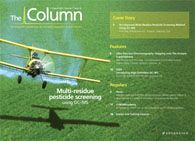Jelly babies
A new study is reporting a method for producing human-derived gelatin, which could provide a substitute for some of the 300??000 tons of animal-based gelatin produced annually.

Gelatin is a well-known biopolymer, especially prominent in the food industry where it is used in gummy sweets and marshmallows, but also used in the pharmaceutical industry for drug capsules and in the cosmetics industry. A new study is reporting a method for producing human-derived gelatin,1 which could provide a substitute for some of the 300 000 tons of animal-based gelatin produced annually.
Gelatin is usually made from the bones and skin of cows and pigs, which may carry a risk of infectious diseases such as “Mad Cow” disease, and can lead to allergic reactions in some people. To avoid this, researchers have developed a method where human gelatin genes are inserted into a strain of yeast, that can produce gelatin with controllable features.
Gel electrophoresis and liquid chromatography coupled with tandem mass spectrometry analysis were used to confirm that the results contained the necessary gelatin proteins. Further spectroscopic tests revealed characteristics consistent with those of gelatin.
The researchers are still testing the human-yeast gelatin to see how well it compares with other gelatins in terms of its viscosity and other attributes.
1. H. Duan et al., J. Agric. Food Chem., 59(13), 7127–7134 (2011).
This story originally appeared in The Column. Click here to view that issue.
New TRC Facility Accelerates Innovation and Delivery
April 25th 2025We’ve expanded our capabilities with a state-of-the-art, 200,000 sq ft TRC facility in Toronto, completed in 2024 and staffed by over 100 PhD- and MSc-level scientists. This investment enables the development of more innovative compounds, a broader catalogue and custom offering, and streamlined operations for faster delivery. • Our extensive range of over 100,000 high-quality research chemicals—including APIs, metabolites, and impurities in both native and stable isotope-labelled forms—provides essential tools for uncovering molecular disease mechanisms and exploring new opportunities for therapeutic intervention.
New Guide: Characterising Impurity Standards – What Defines “Good Enough?”
April 25th 2025Impurity reference standards (IRSs) are essential for accurately identifying and quantifying impurities in pharmaceutical development and manufacturing. Yet, with limited regulatory guidance on how much characterisation is truly required for different applications, selecting the right standard can be challenging. To help, LGC has developed a new interactive multimedia guide, packed with expert insights to support your decision-making and give you greater confidence when choosing the right IRS for your specific needs.

.png&w=3840&q=75)

.png&w=3840&q=75)



.png&w=3840&q=75)



.png&w=3840&q=75)










